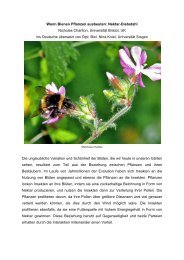PhDâ€theses - Ethologische Gesellschaft
PhDâ€theses - Ethologische Gesellschaft
PhDâ€theses - Ethologische Gesellschaft
Create successful ePaper yourself
Turn your PDF publications into a flip-book with our unique Google optimized e-Paper software.
DETERMINANTS OF NATURAL MATING SUCCESS IN THE CANNIBALISTIC ORB‐WEB SPIDER<br />
ARGIOPE BRUENNICHI<br />
Stefanie Zimmer<br />
zimmer.steffi@googlemail.com<br />
Research Update<br />
Diploma thesis, supervised by Prof. Dr. J.M. Schneider, Department of Biology, Zoological Institute &<br />
Museum, University of Hamburg<br />
Classical sex roles define the most common scenario of promiscuous males and choosy<br />
females which result in polygynous mating systems. Low male mating rates are generally<br />
associated with bi‐parental brood care but occur without paternal investment in various taxa<br />
and have evolved several times independently in spiders. Low male mating frequencies are<br />
associated with remarkable male mating strategies and are predicted to evolve under a<br />
male‐biased effective sex ratio which means that more males than females get to mate.<br />
While male reproductive strategies are well documented and male mating rates are easy to<br />
quantify, especially in sexually cannibalistic species, female reproductive strategies, the<br />
optimal female mating rate, and the factors that affect the evolution of female mating rates<br />
are still unclear.<br />
In this study, I examined natural female mating rates and tested the assumption of a male‐<br />
biased sex ratio and female polyandry in a population of Argiope bruennichi in the field. An<br />
experimental setup was designed that allowed to control female mating status prior to<br />
observations and to monitor mating rates, as well as environmental factors. I predicted<br />
variation in female mating frequencies as a result of (i) spatial and temporal heterogeneity<br />
and (ii) female traits, such as female maturation date, adult weight, and competition with<br />
other females. The possible influence of weather conditions was also assessed. Females had<br />
a low average mating rate of 1.3 and the majority copulated only once. The low degree of<br />
variation was not explained by any of the proposed factors. Male activity and the probability<br />
of copulation were influenced by factors that affected pheromone dispersion such as virgin<br />
female density and wind speed. I conclude that either the assumptions of the theory have to<br />
be reconsidered or alternatively, A. bruennichi males appear to maintain monogynous and<br />
bigynous mating strategies in the absence of obvious advantages over polygamy.<br />
26



